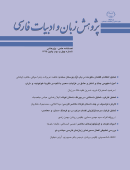تحلیل کارکرد «تمثیل داستانی» در پیرنگ داستان کوتاه
محورهای موضوعی : Research in Iranian classical literature
1 - ادبیات و علوم انسانی
2 -
کلید واژه: روایت تمثیل پیرنگ ساختار داستان کوتاه,
چکیده مقاله :
تمثیل، یکی از فنون بلاغی است که کارکردهای معنایی آن مورد توجه بسیاری از ادیبان قرار گرفته است. از میان انواع تمثیل، نوع داستانی آن که ساختاری روایی دارد، کاربردی وسیع در متون ادبی کلاسیک و معاصر فارسی داشته است. داستان معاصر نیز همانند شعر در موارد بسیاری از کارکردهای معنایی تمثیل بهره برده است. بررسی تمثیلهای داستانی به کار رفته در داستانهای کوتاه مدرن نشان میدهد که برخی از نویسندگان، این آرایه را در کارکردی متفاوت از نوع معنایی آن به کار برده و در بخش ساختاری داستان نیز از آن بهره گرفته-اند. به هدف بررسی این کارکرد، پژوهش حاضر با مبنا قرار دادن آرای «برایان ریچاردسون» دربارۀ تأثیر ساختاری ابزار بلاغی در داستان مدرن، به تحلیل سه داستان کوتاه فارسی («مهدی»، «دوزیستان» و «قصه و غصه») پرداخته و نشان داده است که تمثیل داستانی میتواند علاوه بر کارکرد محتوایی، در ساختار پیرنگ داستان کوتاه مدرن نیز مؤثر واقع شود.
Allegory is one of the rhetorical devices that has attracted a great deal of attention from critics for its semantic functions. Among different types of allegory, fictional allegory which has a narrative structure has had a wide application in classical and contemporary Persian literature. Like poetry, contemporary story has benefited from semantic functions of allegory in many cases. Studying the fictional allegories used in modern short stories, illustrates that some authors have used this device not just for its semantic function, but also it in the structural part of the story. Aiming at studying this function, in this research three Persian short stories (“Mehdi”, “Amphibians”, “Fiction and Grief”) are analyzed based on the ideas of Brian Richardson about the structural effect of rhetorical devices in modern stories to show that in addition to its semantic function, fictional allegory has a role in the plot structure of modern short stories .
